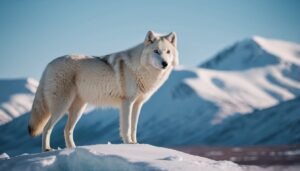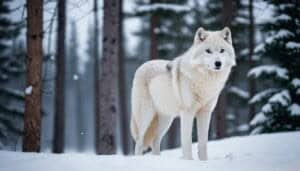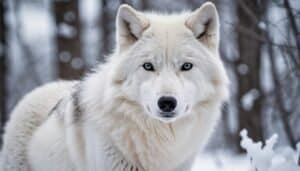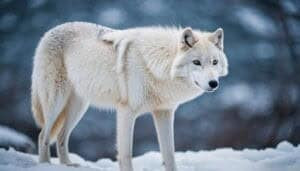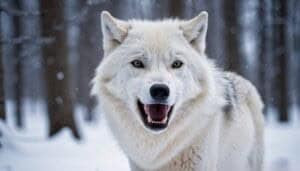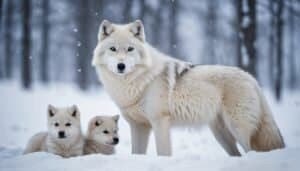Introduction
Arctic wolves live in one of the most extreme environments on Earth, where maintaining hydration is crucial for their survival. This article explores the various strategies and adaptations that enable Arctic wolves to stay hydrated in freezing temperatures
We will discuss their primary water sources, physiological adaptations, the role of diet, and behavioral strategies for finding water. By understanding these aspects, we gain insight into the resilience and ingenuity of these remarkable animals
Primary Water Sources for Arctic Wolves
Arctic wolves have adapted to their harsh environment in numerous ways, especially when it comes to finding and utilizing water sources in freezing temperatures. Understanding these primary water sources provides a clearer picture of their survival strategies
Natural Water Sources
Arctic wolves primarily rely on natural water sources such as streams, rivers, and lakes. However, these sources are often frozen for a significant part of the year. When the ice is not too thick, wolves can break through it to access the water below
In areas where the ice is too thick to penetrate, wolves might find cracks or spots where the ice is thinner, such as near the edges of water bodies or in areas where currents prevent complete freezing
During the brief summer months, when temperatures rise, these water bodies become more accessible. Melted snow and ice provide temporary but vital hydration opportunities. Wolves take full advantage of these periods to rehydrate and prepare for the harsher conditions to come
Accessing Water in Frozen Environments
Accessing water in frozen environments requires ingenuity and persistence. Arctic wolves are known to use their strong sense of smell to locate water under the ice. They may also use their powerful jaws and teeth to gnaw through thinner ice layers. Additionally, wolves can dig through snow to find sources of water trapped below the surface
Another method involves utilizing the moisture content in the snow itself. While eating snow is not the most efficient way to stay hydrated due to the energy required to melt it internally, it serves as an immediate source of moisture when liquid water is unavailable. This behavior is more commonly observed during periods of extreme cold when other water sources are inaccessible
Physiological Adaptations for Hydration
Arctic wolves possess several physiological adaptations that help them maintain hydration in their frigid habitats. These adaptations are critical for their survival, allowing them to endure long periods without direct access to liquid water
Water Conservation Mechanisms
One of the key adaptations is the ability to conserve water efficiently. Arctic wolves have highly efficient kidneys that concentrate urine, reducing water loss. This adaptation is crucial in an environment where water is scarce and temperatures can drop drastically. By minimizing water loss through excretion, wolves can retain more fluid within their bodies, ensuring they remain hydrated longer
Additionally, the metabolic processes of Arctic wolves are adapted to cold environments. They generate metabolic water, a byproduct of the digestion of food, which contributes to their overall hydration. This process allows them to extract maximum hydration from their prey, reducing their dependence on external water sources
Extracting Water from Prey
Arctic wolves are carnivorous and obtain a significant amount of their hydration from the prey they consume. The blood and bodily fluids of their prey provide essential moisture. Wolves typically consume every part of their kill, including blood, which is rich in water and nutrients
The diet of Arctic wolves often includes animals like caribou, muskoxen, and Arctic hares. These animals have high moisture content in their tissues, and by consuming them, wolves effectively hydrate themselves. This adaptation is especially important during winter months when liquid water sources are scarce or frozen
The Role of Diet and Behavior in Hydration
Diet and behavior play crucial roles in how Arctic wolves maintain their hydration levels. Their feeding habits and social behaviors are intricately linked to their ability to stay hydrated
Hydration from Prey
As mentioned earlier, the primary source of hydration for Arctic wolves comes from their prey. By consuming the meat, blood, and internal organs of their prey, wolves extract the necessary fluids to stay hydrated. This method is highly efficient and ensures that they get both nutrition and hydration from a single source
Snow Consumption and Hydration
While not the most efficient method, consuming snow is a fallback strategy for Arctic wolves. They often resort to this method when other sources of water are unavailable. However, this requires energy to melt the snow internally, which can be taxing on their bodies. Despite this, it is a vital survival tactic during the coldest months
Seasonal Behavioral Changes
Arctic wolves exhibit seasonal behaviors that help them adapt to the changing availability of water. During the warmer months, they may travel longer distances to find unfrozen water sources. In contrast, during the winter, they rely more on the moisture content of their prey and occasionally consume snow
Social Behaviors and Hydration
Wolves are social animals and often hunt in packs. This social structure aids in their hydration strategy as well. By hunting in groups, they can take down larger prey, which provides ample moisture for the entire pack. Additionally, the pack can share the responsibility of locating water sources, increasing the chances of finding hydration in the challenging Arctic environment
Conclusion
Arctic wolves exhibit remarkable adaptations to maintain hydration in their extreme, frigid environment. They rely on a combination of natural water sources and innovative methods to access water in frozen conditions. Physiological adaptations such as efficient kidneys and metabolic water production help minimize water loss and maximize hydration
The wolves’ diet, rich in moisture from their prey, plays a significant role in their hydration strategy, providing essential fluids. Additionally, behavioral adaptations, including seasonal changes in water-seeking behavior and social hunting tactics, further support their ability to stay hydrated
These multifaceted strategies showcase the resilience and adaptability of Arctic wolves, ensuring their survival in one of the harshest habitats on Earth. By understanding these complex mechanisms, we gain a deeper appreciation for the ingenuity of Arctic wolves and their capacity to thrive in an environment where hydration is a constant challenge


